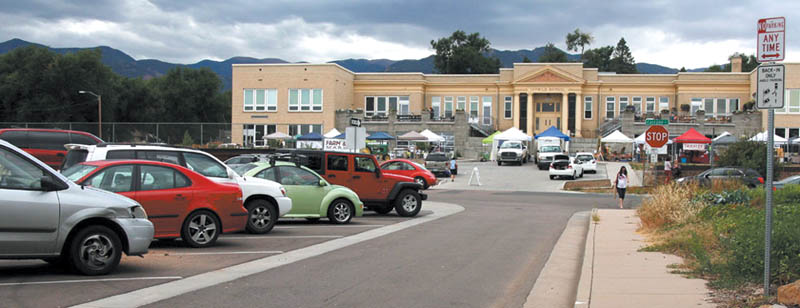2-lane traffic, diagonal parking seen for OCC
City plans striping in 2016, but public will get a say
 A conceptual drawing, prepared for the Old Colorado City Special Improvement Maintenance District, shows the 2500 block of Colorado Avenue restriped for two through lanes, two bike lanes (green) and reverse diagonal parking. Note also the intent for a mid-block crosswalk. Drawing by John Olson for Old Colorado City Special Improvement Maintenance District
|
The concept has been in discussion for about eight years - supported by representatives of the area's property owners and business people.
The two-lane layout would be created by restriping the pavement between 24th and 27th streets. Supporters believe that the change will slow traffic through Old Colorado City, making it more of a destination than a pass-through.
Krager had previously told Old Colorado City she liked the idea. But now that's reinforced by a $12,000 traffic study, done for the city last summer by the Kimley Horn company. In comments at the September meeting of the Old Colorado City Special Improvement Maintenance District (SIMD) advisory committee, Krager said the study revealed that the change could be made “with very little impact to traffic.”
In addition, there would be added parking spaces, resulting from changing the current parallel parking layout to diagonal, according to preliminary plans drawn up for the SIMD last year by design consultant John Olson.
After the meeting, Krager elaborated that public outreach would “absolutely” be part of the changeover process. “Nothing is ever final until we do public involvement,” she said. “Right now it is just a concept.”
A long-time advocate for the two-lane strategy is Jim Heikes, a property owner and avenue merchant who is a past chair of the Old Colorado City Associates (OCCA) business group and currently chairs the SIMD committee. The change would help slow traffic and set apart the three-block area as “more of a destination,” he said in a recent interview. “Right now we're like Woodland Park on the way to Cripple Creek - we're a pass-through for Manitou.”
 The Ivywild School commercial center is in the background in this view west up Navajo Street that shows the reverse diagonal parking arrangement that the city striped onto the left side of the one-way-westbound block between Cascade Avenue and Tejon Street. The sign at far right explains how to park that way. Note: One of these parked cars didn't do what the sign says. Can you pick it out? Westside Pioneer photo
|
A prominent element of the realignment is reverse diagonal parking, in which a car pulls past the space, then backs into it (see graphic on Page 1). The driver can then pull into traffic by going forward.
The thinking is that while reverse-diagonal may take some getting used to, it is ultimately simpler and safer than the parallel parking that's in OCC now. “What's nice is pulling out,” Krager said.
The arrangement is being tried in Colorado Springs on a one-way block of Navajo Street in front of the Ivywild School, between Cascade Avenue and Tejon Street. “Ivywild was the pre-test,” Krager said, half-jokingly to the SIMD committee. “You're the SAT.”
If the Old Colorado City plan goes through as envisioned, another change would be the clear marking of bike lanes, as well as “bike boxes” at stoplights, where bikes would be allowed to wait in front of cars for lights to change.
Krager told the SIMD committee that for Old Colorado City she was OK with straight-in or back-in diagonal parking, but “my one demand is that bike lanes be there as well.” While many Westside cyclists prefer less busy east-west thoroughfares such as Cucharras - in fact, the city plans to use street markings to designate it as a “bike boulevard” - she said that a sizeable number of “commuter cyclists” like to ride fast and need to be accommodated on West Colorado Avenue.
In general, she sees cycling as a “big boon for the community” and believes bike lanes would encourage more of that.
An earlier Olson drawing for Old Colorado City had shown two lanes plus a center lane. But with bike lanes taking up some of the road width, the center lane has been eliminated. Instead, left-turn lanes would be striped near each intersection, the new plan shows.
The change, if it happens, would continue a trend on Colorado/Manitou Avenue. A two-lane scenario with bike lanes is also planned for the No Man's Land project (from 31st Street west to Manitou's Highway 24 interchange), which is due to start construction next year. And, downtown Manitou Springs has been two-laned for about 10 years (although without bike lanes).
Westside Pioneer article